Mass Gang Takedowns are Not ‘Doing Justice’
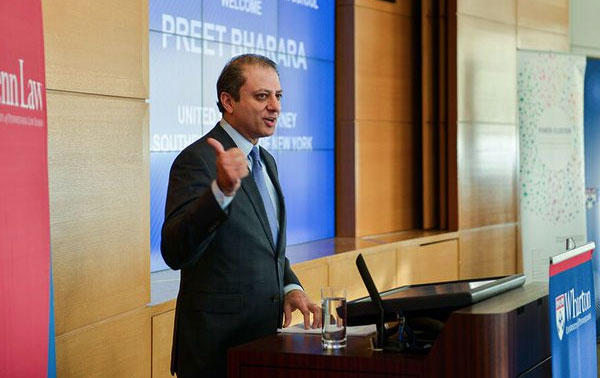
Preet Bharara (photo: @PennLaw)
Former U.S. Attorney Preet Bharara has a new book entitled Doing Justice, which is designed to further establish his position within the “Trump Resistance” by playing up his commitment to the rule of law in the face of the politicized actions of the Trump Justice Department. In it he argues that there is no place for politics in the decisions about which cases to take on and how to prosecute them.
"Certain norms do matter,” Bharara writes. “Our adversaries are not our enemies; the law is not a political weapon; objective truths do exist; fair process is essential in civilized society.”
But this rhetoric of justice and legal formalism stands in sharp contrast to his role in prosecuting young people from the Bronx accused of being “the worst of the worst” as part of the Bronx 120 “gang takedown.”
In 2016 the NYPD and a variety of federal agencies conducted the largest mass arrest of alleged gang members in New York City history, rounding up 120 individuals. Then U.S. Attorney for the Southern District of New York, Bharara undertook the prosecution of those cases using the broad powers of the Racketeering Influenced Corrupt Organizations (RICO) Act. He alleged that these were hardened criminals who had created a vast criminal enterprise that was terrorizing their Bronx community.
Those arrested faced severe felony charges that caused almost all of them to accept plea deals after being held without the possibility of bail for up to two years.
A recent study of the outcomes of these 120 cases by CUNY Law Professor K. Babe Howell calls into question whether the interests of justice were served in these cases.
Howell’s report documents that after three years of court proceedings, 80 of the 120 were not convicted of a violent crime, a third of the defendants spent between zero and two years in prison, and 35 of those arrested were only convicted based on conspiracy to sell marijuana. She also found that almost all the defendants were eligible for a public defender, suggesting that these defendants had no financial resources despite supposedly belonging to a major “criminal enterprise.”
In fact, only around half of the defendants were ever even accused of being gang members. Nearly half of those arrested, including those facing the most serious charges, had already been convicted in state court for the same conduct; some were in prison or jail at the time of arrest.
On the other hand, in one case, Kraig Lewis was arrested in another state while completing a master’s program. He was beating all the odds. He had studied hard through college, as a scholar-athlete, playing basketball, running track, and making the dean’s list. In 2013, he graduated with a bachelor’s degree in criminal justice. He decided to enroll in an MBA program, and was excelling at it, all while paying it back to his community. He coached a kids’ basketball team and created and organized a “Stop the Violence” basketball tournament aimed at raising awareness of gun violence in inner city communities. And through it all, he was raising a young son.
In his final semester of grad school in 2016, on track to receive his MBA, Kraig was arrested in the Bronx 120 raid. The U.S. Attorney’s Office, headed by Bharara, argued that he should be detained without bail, even though he had no criminal record, and had never been in trouble. His classmates graduated, and walked the stage to receive their diplomas. Kraig sat in jail. His six-year-old son went to school without his dad to walk him there. He celebrated birthdays and milestones. He didn’t understand why his dad was gone.
Kraig is out now. He was given a sentence of time served for conspiracy to distribute narcotics (marijuana). But his life is not the same. He remembers seeing a friend stabbed in the neck while he was in jail. He remembers missing his son’s birthdays. He remembers how full of potential his life was, before the arrest. Even though he completed his MBA program through another school while in jail, his future is not the same. Not with a felony conviction.
These prosecutions were clearly political in nature. Bharara and then-NYPD Commissioner Bill Bratton went to extensive lengths to demonize the people arrested in the Bronx 120 raid and presented the public a false narrative that this and other such raids are the way to make communities safer.
Arresting large numbers of people because of their alleged involvement with marijuana dealing, re-arresting people already in prison to produce a show trial, and branding young people struggling to make a future for themselves with a felony record is not justice and it doesn’t create long-term safety for their communities.
Bharara was confronted with the accusations Wednesday night at a Brennan Center event at NYU Law School by the moderator, Margaret Hoover of Firing Line on PBS. He responded that he acted on the advice of the NYPD, whose officials argued that this was the way to respond to an acute crisis of violent crime. He also pointed out that there was community support for some of the other raids he prosecuted in Westchester County.
This defense doesn’t really get to the heart of the issue, and doesn’t match Bharara’s other rhetoric. Prosecutors are supposed to make independent assessments of what is going to produce real justice, not just take the word of the police or respond to the loudest voices in a community. And they certainly shouldn’t agree to broad-based sweeps as conspiracy indictments.
Bharara himself admitted that criminal justice-led solutions, whether directed at violence or Wall Street corruption are unlikely to be successful on their own. We need a more holistic approach that understands the limits of deterrence-based strategies.
This is exactly correct. Instead of relying on police to give us ever-larger groups of socially-networked defendants and putting them in prison for ever-longer sentences, we need to legalize marijuana, provide community-based violence reduction efforts such as Cure Violence, and invest in the lives of young people so that they have real pathways to economic self-sufficiency.
Preet Bharara claims to be “doing justice,” so it is time for him to admit that these mass raids and RICO conspiracy cases are unjust and that those arrested should be given clemency.
***
Alex S. Vitale is professor of sociology and coordinator of the Policing and Social Justice Project at Brooklyn College and the author of The End of Policing. On Twitter @avitale.
***
Have an op-ed idea or submission for Gotham Gazette? Email This email address is being protected from spambots. You need JavaScript enabled to view it.
18 Steps to Increase Transparency at the MTA and Help Restore Public Trust
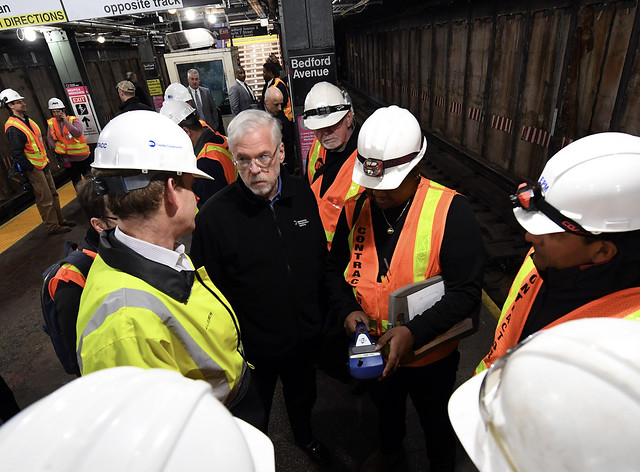
MTA Chair Pat Foye (photo: Marc A. Hermann/MTA)
In recent weeks, Pat Foye, the new CEO/Chair of the Metropolitan Transportation Authority (MTA) has twice publicly committed to improving the Freedom of Information Law (FOIL) and open data processes at the MTA. This is welcome news and an essential step forward for a government authority that has lost a great deal of public trust and is widely perceived as being politicized by the governor’s office. Our organization, Reinvent Albany, will strongly support this push by Foye and we hope it is a small down payment on a new culture of openness.
The MTA is widely seen as having a serious credibility problem with the public and state Legislature. This loss of trust has been aggravated by the tendency of the authority’s top management to treat routine matters as emergencies that must be addressed suddenly, in secret, and outside of existing rules and normal processes. Some days, the MTA seems to operate more like the CIA than a public transit agency. This hurts public confidence in the agency and reduces the political support it needs to make tough decisions about spending and service disruptions.
For its own good, the MTA needs to act like a public transit agency, not the CIA. The core of New York’s Freedom of Information Law is that “a free society is maintained when government is responsive and responsible to the public.”
In the fight for congestion pricing, which Reinvent Albany strongly supports, members of the New York State Legislature expressed frustration at the MTA’s secrecy, and constantly questioned the credibility of information provided by the authority. Some of this was political theatrics by opponents of congestion pricing. But even allies of the MTA were critical, highlighting the gap between the public’s expectations that the MTA be open and honest, and the agency’s habit of shading statistics, telling partial truths, and making it difficult for the public to see underlying data -- including on high-profile issues like Con Edison-caused service disruptions and fare evasion.
We believe the MTA’s lack of candor and transparency is hugely self-defeating and has led directly to the Legislature imposing more and more reporting requirements, including a host of new ones in this year’s state budget.
Fortunately for the MTA, there is a clear path forward on transparency. In early April, Reinvent Albany released Steps Forward for MTA FOIL and Open Data, a comprehensive report on transparency at the MTA, with 18 specific recommendations about how it can improve transparency. We urge the MTA to examine these recommendations, summarized below, and move toward “open by default.” Here are18 Steps Forward for MTA FOIL, Open Data and Transparency:
Open FOIL
1. The MTA should adopt an Open FOIL platform using best practices from other jurisdictions such as LA Metro, the Port Authority of NY/NJ, and within New York State such as NYC Open Records. FOIL requests should be used to prioritize proactive release of information via a “Reading Room.”
2.The MTA should create an in-house MTA Police incident reports portal, allowing the public to privately request incident reports online (incident reports currently make up two-thirds of all MTA FOIL requests). The MTA should work with the NYS DMV to develop their own portal, like the state’s crash reports portal. Other user-friendly models include the State of Pennsylvania crash reports site.
Open Data
The MTA should publish all tables, charts and other tabular data from their performance reports, capital plans, budget documents, Board materials, and other reports as open data. This should include:
3. Full compliance with Executive Order 95, requiring the publishing of all public MTA data on the New York State Open Data portal. Legislation should be considered in this area if compliance cannot be achieved administratively.
4. Release of all underlying datasets that are used to create MTA performance metrics, with full release of methodologies and API access (allowing apps to interface the data automatically).
5. Creating a contracts database that provides full and complete information about projects and vendors.
6. Providing all data from current MTA Board and Budget materials well in advance of meetings in machine-readable, CSV spreadsheet form.
7. Creating an MTA “Open Budget” website for the MTA’s budget information, similar to the state Open Budget NY site.
Budget and Capital Plan Transparency
8. Capital Planning Oversight Committee Materials should be improved through releasing all data in machine-readable, CSV spreadsheet form. Data should always include original project schedules and budgets. All current projects should be listed in the “Traffic Light” report, including those in the CPOC’s Risk-Based Monitoring Program.
9. Budget Documents should be made open and more complete, and released in machine-readable, CSV spreadsheet form. Budget Documents should also provide detailed breakdowns of past yearly expenditures and revenues, going back at least 10 years for both the capital and expense budget, comparing them with past projections.
10. MTA Capital Dashboard should be updated and improved, with improved timeliness of data updates, ensuring that all click-through data can be downloaded in bulk, more data such as contract numbers. The MTA should hold a user-group feedback session to identify additional improvement areas, and expand the “FAQs” Section.
Better Understanding Itself and Its Riders
11. The MTA should conduct and publicly release in an open data format an updated demographic analysis of its riders that looks at age, median individual and family income, race, ethnicity, gender, profession, disability, geographic locations, travel times, and other metrics.
12. The MTA should release more detailed methodology and tabular data about its fare evasion statistics, such as data broken out by borough, subway line, etc.
13. The MTA should release publicly, in an open data format, all data from its customer service portal and all staff analyses of the portal, polls and surveys.
14. The MTA should publicly release, in an open data format, its submission to the FTA of its Transit Asset Management (TAM) plan and the update to its 20-Year Needs Assessment.
15. MTA staff should conduct and release an in-depth “lessons learned” report about installation of Communications Based Train Control (CBTC) on the 7 Line.
Open Meetings Law
16. The Capital Program Review Board (CPRB) should comply with the Open Meetings Law to ensure that all of its deliberations are conducted in public meetings, in particular its votes to approve capital plans and their amendments.
17. A website should be created for the CPRB where it publishes its mission, activities, members, calendar of meetings, meeting minutes and materials, and contact information.
18. All future commissions, advisory workgroups, and other public bodies formed by law to provide recommendations regarding the MTA should fully abide by the Open Meetings Law.
***
Rachael Fauss is Senior Research Analyst and John Kaehny is Executive Director at Reinvent Albany. On Twitter @ReinventAlbany.
***
Have an op-ed idea or submission for Gotham Gazette? Email This email address is being protected from spambots. You need JavaScript enabled to view it.
Zoning for a More Resilient Future

(photo: City Planning Department)
As the threat of climate change grows more prevalent by the day, cities must take the lead in reducing our carbon footprint and becoming more resilient. This year, New York City has taken a big, green step forward, with actions by Mayor Bill de Blasio and the City Council that will decrease our emissions.
When it comes to withstanding the storms and flooding that climate change will bring more frequently, though, it’s vital that existing zoning rules don’t stand in the way of protective measures for the buildings that make up our coastal communities. As sea levels rise, so too will flood waters and we must make certain that zoning accounts for future risk.
Shortly after Hurricane Sandy devastated our coastal communities, the City adopted emergency zoning to enable homeowners to rebuild to more resilient standards, based on the then-newly provided flood maps produced by the Federal Emergency Management Agency (FEMA).
These zoning changes allowed property owners to raise living space and mechanical equipment to a higher elevation that could otherwise wind up under water. They also expire one year after FEMA creates new flood maps. But there’s no telling when the next storm may hit.
When it comes to building or renovating, the hundreds of thousands of residents and businesses in the floodplain can’t be kept in limbo. We need to provide guidelines for how buildings can be constructed or retrofitted to better withstand or recover from storms and flooding. This affects roughly 400,000 residents in today’s flood zone, an area that could increase in size to cover nearly 800,000 New York City residents by the 2050s due to sea level rise.
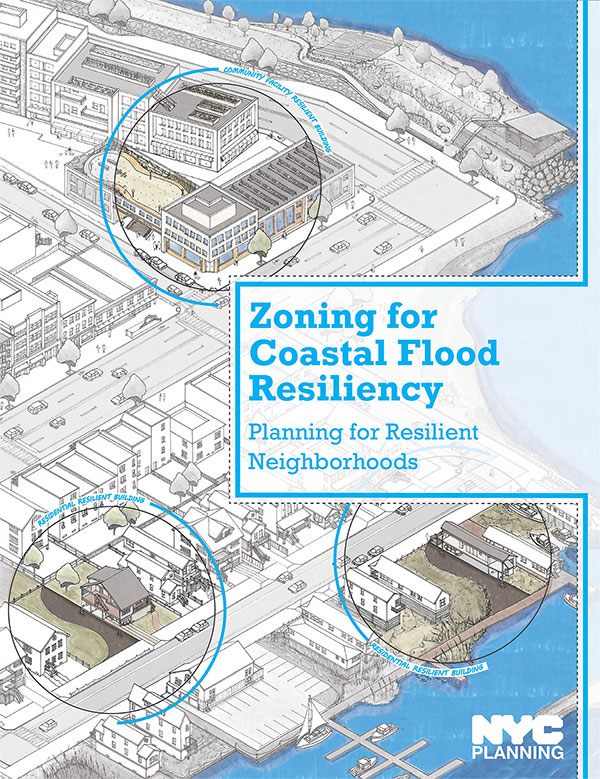 With years of lessons from Sandy recovery and community outreach, we’ve created Zoning for Coastal Flood Resiliency, rules tailored to New York’s diverse neighborhoods, building types, uses and needs, as well as increased storm and flood risk from climate change.
With years of lessons from Sandy recovery and community outreach, we’ve created Zoning for Coastal Flood Resiliency, rules tailored to New York’s diverse neighborhoods, building types, uses and needs, as well as increased storm and flood risk from climate change.
We have listened to communities throughout the City’s flood zones to understand the challenges they face both from storms and increased chances of flooding due to climate change. Zoning for Coastal Flood Resiliency is responsive to what we heard and will allow New Yorkers to make smart choices when retrofitting or rebuilding.
The proposal’s main goals include:
Expanded geography: We saw during Hurricane Sandy that floodwaters ignore lines drawn on maps. Much flooding occurred well beyond the boundaries of the old Flood Maps. With climate change and rising sea levels, storms will become more frequent and floodwaters will travel further inland. We’re expanding the proposed zoning protections from the 100-year floodplain to the 500-year floodplain, ensuring that an additional 44,600 buildings in the city that house nearly 350,000 additional residents can become more resilient.
Flexibility for resiliency: Residents told us that current zoning often forces their resilient measures to eat into living space in their homes. In response, we propose to allow sea level rise to be factored into designing new buildings or retrofitting existing ones, offering more room for resiliency. This flexibility will give resilient buildings a decreased chance of property damage from a future storm and likely reduced flood insurance costs.
Alternatives for the relocation of important equipment: For buildings to quickly get back up and running after flooding, it’s critical that their mechanical, electrical and plumbing equipment or back-up systems are above floodwaters. The zoning would allow them to be elevated.
On a personal and a macro level, New Yorkers are still feeling the impact of Hurricane Sandy. It’s imperative to apply lessons learned from that disaster and emerge stronger. These zoning measures will help individual property owners prepare for a resilient future.
This is just one piece of the puzzle. When combined with the City’s investments in coastal protection and the hardening of our infrastructure, we can provide real and tangible risk reduction from coastal storms.
***
Michael Marrella is Director of Waterfront and Open Space at the Department of City Planning. On Twitter @NYCPlanning.
***
Have an op-ed idea or submission for Gotham Gazette? Email This email address is being protected from spambots. You need JavaScript enabled to view it.
A Lion of City Government Issues a Warning
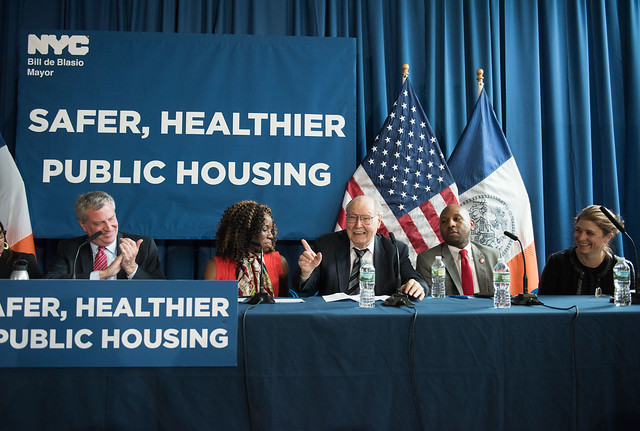
Stan Brezenoff, middle (photo: Michael Appleton/Mayoral Photography Office)
The dramatic growth in the size and cost of city government since Mayor de Blasio took office has been of concern to budget watchdogs: the number of city employees has grown by 35,000 and total annual spending by more than $20 billion since 2014.
The mayor’s latest budget presentation, delivered last week, came with talk of fiscal prudence, but assuaged few fears, including those of an unexpected new source adding his voice to those warning about the city’s long-term health.
The $92.5 billion proposed operating budget for the fiscal year that will begin on July 1 includes over $1 billion more in city-funded expenditures than was anticipated by the mayor’s Preliminary Budget released only a few months ago, offset by increases in revenue and “savings” through a variety of expenditure adjustments, netting out to an increase of about $350 million in planned spending since the mayor’s prior plan.
The budget for the coming fiscal year is balanced but the projected deficit for the 2020-2021 fiscal year is estimated to be $3.5 billion. The revised 10-year Capital Strategy is increasing a whopping $13 billion -- to nearly $117 billion.
The mayor stressed that his plan is fiscally prudent and that new initiatives have been kept to a minimum out of an abundance of caution about possible threats to the city’s economic picture. But Citizens Budget Commission President Andrew Rein succinctly summarized the general reaction from watchdogs and other commenters:
“Mayor de Blasio’s stay-the-course budget does not take the steps needed to preserve services or forestall tax increases in the eventual hard times.”
Will our city’s elected leaders heed the warnings and restrain their impulse to find more “savings” and add more spending to the budget that is finally adopted by the end of June? Not if past behavior is any guide.
But perhaps they will listen to someone who should command respect from the mayor and City Council alike: Stanley Brezenoff.
Last Friday, the day after the mayor presented his updated budget plans, Stan received the Civic Fame Award from the Center for New York City Law at New York Law School. his remarks were reflections about his years in government and the nature of the three mayoral administrations he has served. They were thoughtful, nuanced, and unexpected.
Stan started out as a young activist in the civil rights movement working for the Reverend Milton Galamison, who led the fight for community control of city schools in the 1960s. Indeed, it was noted at the award ceremony that Stan had some trouble getting a full-time job in New York because he had so many arrests from protests on his record.
Stan entered city government in the administration of Mayor John Lindsay, went on to various positions including as the first commissioner of the newly formed Human Resources Administration, was Executive Director of the Port Authority, and eventually became First Deputy Mayor under Ed Koch, which is when I first met and worked for/with him.
I was fortunate to work with Stan again when he was the Vice Chair and I was President of the September 11th Fund, and since then we have been friends and colleagues on various projects.
Given Stan’s extensive background and his long relationship with then-First Deputy Mayor Tony Shorris (who was his deputy and successor at the Port Authority), it is not surprising that Mayor de Blasio has relied on Stan to help deal with some of the weightiest challenges of his administration – first as an advisor on labor relations, then as Acting CEO of the city’s financially-strapped Health + Hospital system (which he ran 1981-1984), and most recently as Acting Chair of the beleaguered public housing authority, NYCHA.
So, suffice it to say, this is not someone who can be dismissed as a conservative, anti-government pundit who doesn’t care about the city’s social safety net or believe in unionized public employment. That is why his comments, while diplomatic, were especially noteworthy and startling.
His main points were:
-Mayor Lindsay came into office in 1966 at an important inflection point. He had an expansionist, activist agenda driven by social goals, i.e. equality and attention to the needs of the poor.
-Lindsay attracted a young, energetic staff that shared his agenda and they accomplished a great deal.
-But they were not prepared or oriented towards the tasks needed to manage the large business enterprise that is city government; hence the seeds of the fiscal crisis were sown.
-Mayor Abe Beame (1974-1977) and his administration lacked the understanding and tools to address the magnitude of the financial challenges that became apparent. Capital funding had been borrowed and used to support operating expenses and now the banks were refusing to loan the city government any more money.
-Mayor Ed Koch (1978-1989) brought a management perspective to the job. Because of the fiscal crisis the public psyche had changed and it became “easier to say no” to advocates and new social policies because there simply wasn’t enough money to do everything. Koch and his administration, subject to the constraints imposed by the Emergency Financial Control Act, engineered a financial turnaround that put the city on a stable footing.
-Moving forward to the present, the current administration is experiencing an extraordinary period of affluence that has enabled Mayor de Blasio, as did Lindsay, to focus on an expansionist social agenda. While his achievements –- e.g. universal pre-kindergarten, an aggressive affordable housing program – are laudable and important, there has been less attention to enterprise management functions and there are warning signs that good times will not last much longer.
-There has been little emphasis on efficient service delivery and achieving savings. The annual PEG (Program to Eliminate the Gap) that has been required by all mayors since Koch to exert savings discipline upon agency spending has been absent 2014-2018.
-This is the first budget of the de Blasio administration in which a PEG has been imposed, but it was “not very vigorous.”
-Good stewardship requires remembering and learning from history. Expansionist policies cannot be implemented without good fiscal management to sustain them.
Thus, in a very nuanced, diplomatic way, 40-year veteran of government Stan Brezenoff offered the same message as Andrew Rein from CBC: we are taking the good times for granted and are not prepared for a recession or some terrible crisis that rapidly decreases revenue and catches the city unprepared to fund all its current expenses and significant long-term liabilities.
City Council and mayor: listen up! Stan Brezenoff has committed his life to social justice. He is not anti-union or a believer in small government. If he is worried, you should be too!
Don’t make the situation worse by adding pet projects to what the Executive Budget already includes. Any more revenue that turns up should be put into reserves for that rainy day. We are far short of the $12-15 billion that would be needed to weather a recession.
The public and Stan B will be watching.
[Watch Stan Brezenoff’s comments in full here.]
***
Carol Kellermann was president of Citizens Budget Commission from 2008 through 2018.
***
Have an op-ed idea or submission for Gotham Gazette? Email This email address is being protected from spambots. You need JavaScript enabled to view it.
The Opportunity Ahead for the New CUNY Chancellor
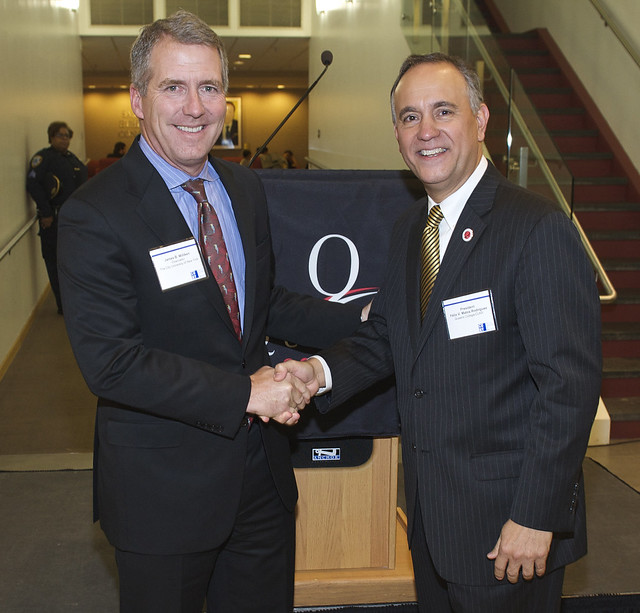
Former CUNY Chancellor James Milliken, left, & incoming Chancellor Felix Matos Rodriguez (photo: CUNY)
Today -- Wednesday, May 1 -- Felix Matos-Rodriguez assumes the post of CUNY chancellor following a year-long search. After successfully leading two CUNY colleges, Chancellor Matos-Rodriguez takes over an institution that has made important strides in recent years, including opening an innovative new community college and launching nationally renowned programs like CUNY ASAP.
To help grow New York City’s middle class and greatly expand economic opportunity, CUNY’s next leader will need to make boosting college and career success his highest priority.
The nation’s largest urban public university provides many thousands of New Yorkers from low-income backgrounds with an education that can make the difference between persistent economic struggle and transformative economic and social mobility.
But CUNY still has work to do. Too many students drop out without a credential; graduates do not always end up on the path to career success; curriculum development can lag behind the city’s fast-changing economy; and CUNY sometimes struggles to tune in to the needs of employers.
There’s no time to lose. Today nearly 3.4 million New Yorkers age 25 and older lack any sort of post-secondary credential, exacerbating the city’s opportunity divide. While nearly 61% of Manhattan residents hold a bachelor’s degree or higher, the same is true for just 19% of those in the Bronx.
For residents without a college credential, far too many of the city’s growing, well-paying occupations -- from software developer to registered nurse -- remain out of reach.
Narrowing that divide depends on CUNY.
There’s no institution better positioned to help lower-income and first-generation students earn a post-secondary credential -- and with it, the opportunity to participate in and shape the economy of the future. But despite recent progress, only 22% of students who enter CUNY's community colleges graduate in three years. At CUNY’s senior colleges, just 55% earn a degree in six years. Getting more New Yorkers on the path to economic opportunity will require a major effort to increase the number of students who graduate with a degree.
The new chancellor’s first goal should be to dramatically improve those figures. Fortunately, CUNY has at least two programs proven to significantly boost completion rates: CUNY ASAP and CUNY Start.
ASAP provides a set of integrated supports to community college students, including free MetroCards and intensive academic counseling. Start is a bootcamp program that significantly boosts academic readiness for underprepared students without burning through their financial aid. Both programs should be made available to all community college students, and a version of ASAP should expand to senior colleges, too.
While it’s true that most community college students enter the classroom struggling with at least one core subject, traditional remedial programs just don’t work. Students in these programs are far more likely to drop out, even though research shows that most can succeed with a little help.
Chancellor Matos-Rodriguez should champion a system-wide effort to move away from traditional remedial education in favor of highly effective alternatives like the corequisite model, which allows students to pursue credit-bearing courses from day one with extra support.
But the challenge for the next chancellor doesn’t end at graduation day. CUNY lacks a strategy to ensure that a CUNY credential leads to career success.
The next chancellor should lead a major effort to engage employers around every campus and develop industry-informed curricula tailored to growing occupations in tech, hospitality, creative industries, healthcare, construction, and beyond.
This will require CUNY to quicken the pace of development for new programs and courses and speed up technology procurement -- and New York City and State should support these efforts with more funding for employer engagement and a faster approvals process for new programs. Additional goals should include launching new apprenticeship programs with industry partners, expanding the number of internships and work-study opportunities available to CUNY students, and pushing to increase and improve career counseling services.
CUNY should also take steps to develop new certificate programs -- designed in partnership with employers, unions, or trade associations -- that can provide community college students with a marketable credential that counts toward a two- or four-year degree.
Doing all this will require sustained and expanded support from New York City and State. But it will also depend on strong and creative leadership at a decisive moment for public higher education. The new chancellor should ensure that CUNY’s faculty, administrators, and curricula have the flexibility to move at the speed of technology and a clear mandate to prepare students for the jobs -- and opportunities -- of the future.
By focusing his administration on elevating college and career success, Chancellor Matos-Rodriguez can help the nation’s largest urban university become its most effective launchpad to the middle class.
***
Jonathan Bowles is executive director of the Center for an Urban Future, a New York City–based think tank focused on expanding economic opportunity. Winston C. Fisher is partner at Fisher Brothers and co-chair of the New York City Regional Economic Development Council. On Twitter @jbowlesNYC & @Wnston_Fisher1 & @nycfuture.
***
Have an op-ed idea or submission for Gotham Gazette? Email This email address is being protected from spambots. You need JavaScript enabled to view it.
Why is Rep. Hakeem Jeffries MIA on the Green New Deal?
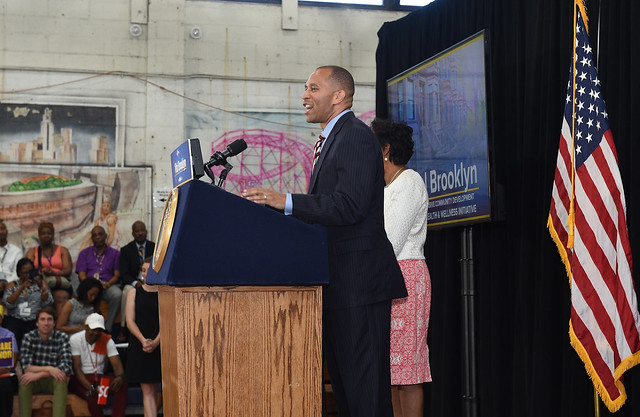
Rep. Hakeem Jeffries (photo: Kevin Coughlin/Office of Governor Andrew M. Cuomo)
The Green New Deal resolution has garnered a lot of attention since it was introduced in February. The nonbinding resolution, sponsored by Rep. Alexandria Ocasio-Cortez (D-NY) and Senator Edward J. Markey (D-MA), aims to reshape our energy system and economy by committing to a swift and just transition to 100% clean renewable energy.
Such a bold transformation is exactly what is needed according to the International Panel on Climate Change (IPCC) in order to avoid the worst effects of climate change. After all, the IPCC explained that we only have twelve years to get our emissions under control or else we will be locked in to climate catastrophe.
The Green New Deal promises not only to get us off fossil fuels, but will also create millions of good jobs retrofitting existing buildings so they are more energy-efficient and boosting wind and solar energy investments. The resolution also aims to protect frontline communities and those most affected by climate change and pollution.
The Green New Deal has attracted considerable support in a rapid time, receiving endorsements from nearly all Democratic contenders for the presidency and having over 90 co-sponsors in the House of Representatives. According to a Business Insider poll, over 80% of respondents support almost all of the components of the Green New Deal resolution. Of course, the resolution has garnered its critics too, with President Trump referring to it as “socialism.”
Nearly all of the congressional representatives from New York City signed on as co-sponsors to Rep. Ocasio-Cortez’ resolution. However, there remains a glaring omission in Rep. Hakeem Jeffries (D-NY). Rep. Jeffries represents a solidly blue district in Brooklyn and Southwest Queens which has already witnessed the devastating effects of climate change firsthand with Hurricane Sandy wreaking havoc along the Brooklyn-Queens waterfront. In fact, his 8th congressional district received more aid for Hurricane Sandy relief than any other district in the city.
While there is wide support for the resolution, the Democratic leadership in Congress remains disinterested in moving forward, exemplified when House Speaker Pelosi laughed off the resolution by calling it the “green dream.” Likewise, Mitch McConnell’s stunt vote in the Senate failed to garner a single Democratic vote. The Democratic Party leadership in Congress, including Rep. Jeffries, should demonstrate that they are committed to tackling climate change head-on by supporting the Green New Deal.
Rep. Jeffries is certainly a major player and rising star within the Democratic Party, as he was elected chair of the House Democratic Caucus, and is rumored to be on the fast-track to be Speaker of the House. Interestingly, Rep. Jeffries owes his current leadership position in part to Rep. Alexandria Ocasio-Cortez, who ousted the previous chair of the caucus, Rep. Joseph Crowley, in a primary.
Rep. Jeffries should prove his progressive bonafides by supporting the Green New Deal. Indeed, it may be bad politics for him to avoid the resolution; he wouldn’t want the same fate of Rep. Crowley by being primaried from the left.
As it currently stands, Rep. Jeffries and freshman Rep. Max Rose (D-NY) are the sole New York City members of Congress to fail to sign on to the Green New Deal. Rose represents another area massively affected by climate change and Hurricane Sandy -- Staten Island and Southern Brooklyn. However, Rep. Rose’s district is hardly safely Democratic, and he does not need to fear a primary challenger from the left.
To be sure, the Green New Deal is only a nonbinding resolution and doesn’t actually enact any measures that will reduce greenhouse gas emissions. Rather it sets the vision and the goals to massively transition the economy away from its reliance on fossil fuels.
Rep. Jeffries has indicated that rather than signing on to the Green New Deal, he is inclined to wait until the bipartisan “House Select Committee on the Climate Crisis” makes recommendations on the issue, a process that can take over a year. However, with climate change, time is not a renewable resource. It is essential that congressional leadership at least entertain solutions commensurate with the challenges we face. Rep. Jeffries should show the courage and leadership on the climate and support the Green New Deal.
Rep. Jeffries has a duty to his constituents to support policies that will reduce carbon emissions, create green jobs, and build up the infrastructure that protects his district from the next superstorm. After all, not only is it good politics to support the Green New Deal, but according to the world’s top scientists, it is absolutely necessary policy. To show true leadership, for his party and the country, Rep. Jeffries should champion the Green New Deal.
***
Ari R. Lieberman is an attorney and the legislative coordinator for 350Brooklyn, a grassroots climate change organization affiliated with 350.org. On Twitter @the_greenmarble.
***
Have an op-ed idea or submission for Gotham Gazette? Email This email address is being protected from spambots. You need JavaScript enabled to view it.
Heading in the Right Direction on City and State Census Funding, But More To Do
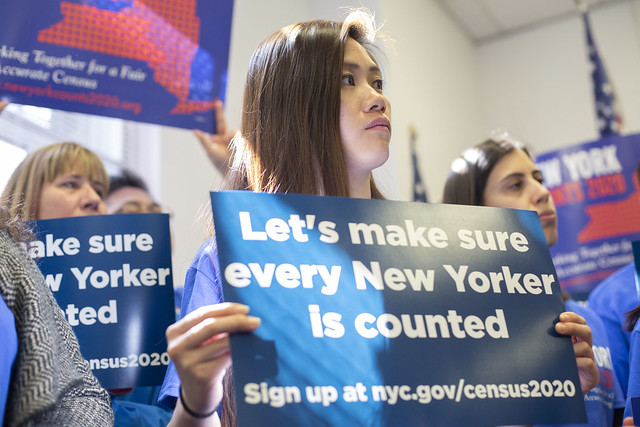
(photo: John McCarten/City Council)
The 2020 Census is less than a year away, and it is imperative that every single person living in New York is counted. In Mayor de Blasio’s proposed Executive Budget, New York City now has $26 million set aside for census outreach, in addition to an undetermined portion of the State’s $20 million that will go to the City.
A good start, but we need more than $26 million to ensure a full count, and with less than a year to go before the counting begins, there is still too much uncertainty about how much of and how fast these funds will make their way to the organizations doing the work on the ground.
This uncertainty is particularly alarming because of how much coordination we need between the City and State to achieve a complete count. We cannot allow anything short of a comprehensive funding strategy to happen. There is too little time and too much at stake, and a smart down payment in 2019 will pay billions in federal dividends if the census is a success.
We’re talking about upwards of $73 billion in federal funding for food, schools, housing, and more for the state. Our representation in Congress is on the line. Even how we draw our State and City district lines is affected. Getting the census right isn’t a wonky statistical game. It directly affects the flow of federal resources going to New York and will determine our economic and political future for the next ten years.
Unfortunately, the U.S. Census Bureau has a hard time counting New Yorkers. More than half the people who live in Brooklyn, Queens, and the Bronx live in “hard-to-count” neighborhoods, which the Census Bureau defines as areas with a self-response rate of 73% or less in the past census. Such neighborhoods exist in Manhattan and Staten Island as well. The hardest-to-count populations are already among our most vulnerable and underrepresented – immigrants, people of color, low-income people, people with limited English proficiency, and young children.
Yet instead of increasing funding for the Census Bureau, President Trump has slashed it to its lowest point in decades and is fighting to include a citizenship question in the Census that would further depress participation.
Many groups in New York recognize the importance of this moment and have mobilized to ensure a complete count, from community-based organizations, religious leaders, unions, and the business community.
Some of the most trusted and well-regarded advocacy organizations in the State – the New York Immigration Coalition, Asian American Federation, Citizens Union Foundation, NAACP, and Association for a Better New York, among others – have formed coalitions and started educating New Yorkers about the importance of completing the census.
Yet none of these groups can succeed without a commitment from government to work together and fund their efforts directly. These groups know how to reach hard-to-count populations and mobilize them to participate. And through the City Council’s Census 2020 Task Force, the Council can identify even more trusted hyperlocal groups for direct funds to ensure a complete count.
We believe the City and State should combine their efforts and use the most direct routes possible to fund these local census outreach operations to their maximum potential. We also believe we can do better and that the City and State must increase census funding to truly meet the challenge we face.
This is a one-time investment in our economic and political future. There are no do-overs. We will not have a chance to correct any mistakes for another ten years and will live with the effects of an undercount for a decade. We must treat this emergency with the importance it demands.
In ten years, we will either look back knowing we seized the opportunity to control our economic and political destiny or wonder why we lost out on billions for ordinary New Yorkers to save millions upfront. When you consider the choice, the answer is obvious. The City and State must work together and fully fund this effort.
***
Steven Choi is executive director of the New York Immigration Coalition. City Council Members Carlos Menchaca and Carlina Rivera are co-chairs of the Council’s Census Task Force. On Twitter @SteveChoiNY & @cmenchaca & @CarlinaRivera.
***
Have an op-ed idea or submission for Gotham Gazette? Email This email address is being protected from spambots. You need JavaScript enabled to view it.
How the Mayor and NYPD Must Step Up for Sexual Assault Accountability
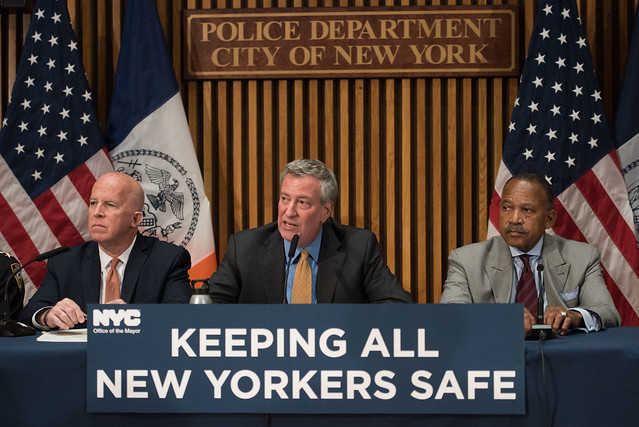
(photo: Michael Appleton/Mayoral Photography Office)
Not nearly enough has been done to improve New York City’s response to sexual assault in the one year since the New York City Department of Investigation (DOI) issued a blistering report on how the NYPD was failing to make sexual assault response a priority. Mayor Bill de Blasio’s primary response to the report has been to question its accuracy.
The mayor needs to see that many of the failures documented by the DOI persist today and recently released figures show an alarming one in four rape cases were closed in 2018 due to an alleged lack of cooperation from the victim. In Manhattan, a shocking 40% of all rape investigations were closed citing uncooperative victims and unfounded allegations. A high rate of rape victims not cooperating with police is a red flag pointing to ineffective investigations and likely mistreatment of victims.
The pressure is mounting for this global city that is home to 8.6 million residents and 60 million tourists a year to keep pace with resources and innovation. In the Me Too era reporting continues to rise, and what's more, survivors are taking their complaints public, victims are suing the NYPD, and a state law is about to go into effect that mandates law enforcement agencies adopt policies that are victim-focused and trauma-informed.
What the DOI investigation documented in its 165-page report should be of concern to every New Yorker: a severely understaffed division; too many officers with limited investigative experience; insufficient training; cramped facilities in need of upgrading; and a failure to take acquaintance rape as seriously as stranger rape. Indeed, the report found that although there were more than 5,600 sex crime cases in 2017, by last year there were only 67 detectives to handle them.
The NYPD has made some important changes in response to the report's findings. The department started sending all acquaintance rapes, not just all stranger rapes, to SVD. This is a significant change, but it’s also one that will require more SVD staff and resources to handle the additional cases. The department has also committed to revamping SVD’s facilities in every borough, a welcome change for detectives and survivors. However, more needs to be done and that need is urgent.
A senior advisor to Mayor de Blasio issued a statement calling the NYPD’s investigative efforts “the best in the nation” a year ago. It wasn't true then, and it isn't true today.
Advocates who work with New York City survivors continue to see too many cases falling through the cracks and basic procedures lacking. We've seen failures to call victims back, to keep them informed of their cases, to demonstrate that leads were pursued quickly and evidence was collected in a timely manner, and to meet victims with compassion, concern, and cultural competence. There are undoubtedly many dedicated and experienced investigators in SVD, but without a top to bottom culture shift across the division and investment of more resources, too many victims will get a substandard response. For these people, the experience of reporting can become a painful continuation of trauma, rather than a start to healing.
We continue to call on the mayor and the NYPD to:
-Build a culture that demands meeting all survivors with compassion and professionalism. Research demonstrates that meeting survivors with belief and support not only impacts the trajectory of their healing but helps investigators obtain better information and results. In fact, a strong victim-centered approach was recommended in the U.S. Department of Justice report on preventing gender bias in law enforcement.
-Significantly increase the number of detectives within SVD to lower caseloads: DOI calculated that at least 140 investigators dedicated to the adult squad were needed to do an adequate job, and this was before accounting for the rising reports of sexual assault. Although the NYPD has increased the number of SVD investigators, the recommended number has not yet been met.
-Significantly increase the investigative skill level of those assigned to the division: only 5% of SVD investigators are First-Grade Detectives, those detectives recognized with the highest level of investigative experience. Increasing opportunities for promotion within the division and engaging more experienced investigators from the outset lays the groundwork for a stronger and more effective unit.
-Provide more and better quality training to SVD. The move to ensure that every SVD investigator is trained in trauma-informed interviewing techniques was a significant investment and critical step in the right direction. We’ll continue to push for expanded training until it’s clear that all sex crime investigations are timely, competent, and robust.
We shouldn’t stop at just making changes to the NYPD, that’s just one small piece in addressing sexual assault. New York City aspires to be a model for the rest of the nation on so many fronts -- why not on sexual assault? A comprehensive approach is needed.
We can make consent and healthy relationship education part of every New York City child’s experience pre-kindergarten to 12th grade. We can launch evidence-based public-service campaigns that aim to shift cultural attitudes and beliefs that perpetuate abuse and invest in survivor-led and community-based outreach to prevent violence.
Me Too has done a great deal to break down taboos and to raise awareness of how ingrained and routine sexual assault is in our culture. April is sexual assault awareness month – it should be sexual assault accountability month. And accountability lies with the mayor of New York City, who has a great opportunity to tackle a societal problem with the urgency, investment and innovation it deserves.
***
Sonia Ossorio is president of the National Organization for Women - New York. On Twitter @soniaossorio & @NOW_NYC/@NOWNewYork.
***
Have an op-ed idea or submission for Gotham Gazette? Email This email address is being protected from spambots. You need JavaScript enabled to view it.
Ending the Shortage of Black Male Teachers in New York
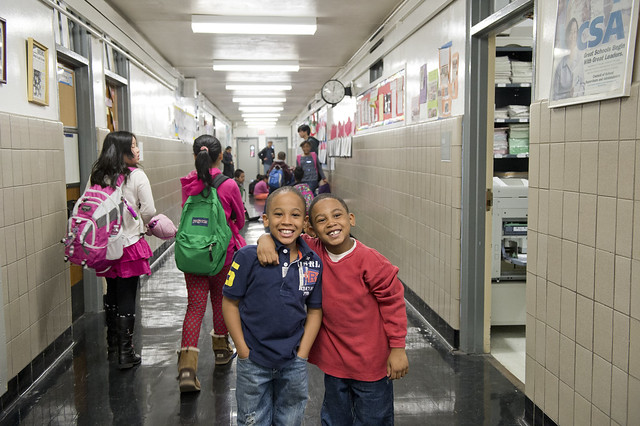
(photo: New York City Department of Education)
Every day I stand in front of my classroom, filled with black and brown faces, intensely aware that I am the only black man teaching at my school -- but I am hardly the only one that feels this. New York City schools employ fewer black male teachers today than 20 years ago; only 3.7 percent of city teachers share my identity.
Without male teachers of color, thousands of students walk into schools each day where not even a single adult shares an important part of their identity. These students are missing out on the academic and social advantages of having a teacher of color. Studies show that having a race and gender match between student and teacher can help reverse some of the challenges black male students face -- higher dropout and suspension rates coupled with lower likelihood to attend and graduate from college.
It is time for New York to seriously invest in recruiting excellent black male educators.
A diverse teacher workforce had a deep impact on my life. Growing up in Miami, I was one of the few black boys in my schools. Fortunately, black educators like Mr. Carter, my mentor and role model, pushed me to become the learner and educator I am today. He validated my voice and writing in English, a subject where black boys did not typically fit in. Mr. Carter, and other black male teachers, put me on the trajectory to become a lifelong educator.
When I started educating a new generation of black students, I carried on the mission Mr. Carter sowed in me. In my classroom, I am not just a teacher or track coach. To my black students, I am a father, uncle, big brother, and mentor.
Brandon, a student from years ago, told me that having a role model that looked and spoke like him teaching history put him on the path to studying history and returning home as an educator himself. Last week, Brandon used his spring break to shadow and co-teach in my Manhattan classroom. He is joining the next generation of black educators making a difference in the lives of black kids.
When our students open their eyes to new subjects, career paths, and futures they never saw for themselves, that’s where we see our true impact. Our connection goes beyond academics and test results; I see myself 20 years ago and they see me as someone they can become.
The debate over how schools support black boys facing systemic racism and poverty often overlooks the impact teachers of color, and specifically black male teachers, can have. Our school system marginalizes our black students by suspending them at higher rates and limits their access to higher level courses.
Having a same-race teacher improves academic and social performance, shown by The Institute for Labor Economics. It found that when a black male student from a low-income background has one black teacher in elementary school they are 39% less likely to drop out of school and more likely to attend college.
Additionally, there are lessons that only a black man can pass on to a black boy -- how to survive an encounter with the police, how to code switch, how to resolve disputes with your words -- which is why studies show black students are suspended less by black teachers. Having a black male teacher is one way to address these problems and ensure our black boys are on the path to graduation, college, and success beyond.
While teachers have offered pathways to end the chronic shortage of black male teachers, New York has not done enough. Recently, Educators for Excellence-New York, a teacher-led advocacy group, released recommendations aimed at increasing teacher diversity in New York by investing in preparation programs that excel at recruiting and training excellent teachers of color. Unfortunately, state leadership continually fails to sufficiently address this issue.
Governor Cuomo and the Legislature included money in this year’s state budget to recruit 250 teachers of color by 2024 -- in a state that produces nearly 10% of all new American teachers each year. This is a small, positive step. But in a system where 40% of our students are males of color, these proposals are insufficient.
Truth be told, it goes beyond funding. It’s time for political leaders to authentically implement inclusion and expand effective initiatives that will develop, support, and sustain a pipeline for black male educators into the classroom.
As Educators for Excellence-New York recommends, it is time for the state to identify and support teacher preparation programs that are successfully recruiting and training men of color to teach. These programs must include teacher residencies that provide extended in-classroom experience in the schools that need educators of color the most.
Additionally, it is time to for school districts to prioritize hiring and retention strategies that address the unique challenges facing men of color as they enter and grow in the profession. With a sustained approach, New York can become a leader in what it looks like to address teacher shortages and close the educator diversity gap.
Across New York, there are young men sitting in classrooms, just like I once was, whose lives could be changed by a role model at the front of their classroom that looks like them.
***
Ashley Toussaint is a public high school teacher in Manhattan and a member of Educators for Excellence-New York.
***
Have an op-ed idea or submission for Gotham Gazette? Email This email address is being protected from spambots. You need JavaScript enabled to view it.
We Can't Let Trump Reverse Years of Improved School Food Policy
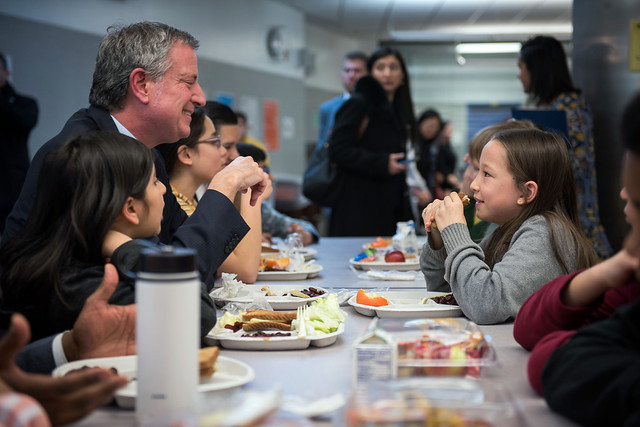
(photo: Ed Reed/Mayoral Photography Office)
My nephew is 10-years-old, is obese, and has type-2 diabetes. He wasn't raised to eat healthy, and my sister and brother-in-law don't always do the best to encourage good eating habits. One place they have no control over my nephew's diet is at school.
He's in 5th grade in a public school in northern Manhattan. He often tells me what he has for breakfast and lunch at his school, and laughs when he sees my reactions to what he describes. Bagel sticks with cream cheese and jelly, cinnamon twists, juice, and chocolate milk are just a few of the items he brags about that taste good.
New York City's public schools have come a long way in improving the quality of school food over the years. The city has worked hard to make school meals healthier than other cities across the country, and the Obama Administration was on the same page when it passed the Healthy, Hunger-Free Kids Act in 2010, which aimed to serve more nutritious and fiber-dense whole grains and less flavored milks, which contain harmful added sugars.
But then came President Trump, and in December 2018 his administration weakened the law by reversing limits on sodium, allowing flavored milks and reducing whole grain foods in school food. Earlier this month a coalition of state attorneys general and two food policy advocacy groups sued the Trump Administration for violating the Administrative Procedure Act and the Healthy, Hunger-Free Kids Act by authorizing the reversal last December and bypassing legal requirements.
As a graduate student at NYU’s Robert F. Wagner Graduate School of Public Service, I’m passionate about improving public health (like my 10-year-old nephew's) through improved food and public health policies. I wrote a food policy brief last fall for one of my classes, arguing that New York City public schools should eliminate flavored milk during breakfast and lunch and instead offer plain milk as the default. It also proposed making 100% fruit juice available during breakfast and only upon request by the student.
Using evidence-based research, I explained that both flavored milk and 100% fruit juice are large contributors to diet-related chronic diseases like obesity and type-2 diabetes, which affect not only many adult New Yorkers, but children as well.
According to the New York City Department of Health and Mental Hygiene, one in five city kindergarten students is obese. Studies show that obese children are at increased risk of becoming obese adults, and statistics show that obesity is more prevalent among black and Hispanic people compared to those of other races.
There is already strong scientific evidence linking poor quality school food, like flavored milks, to diet-related chronic diseases. However, many people (even doctors and nutritionists) are misled that 100% fruit juice is healthy. The sugars in these juices, even though all natural, are just as bad as added sugars in soda. Sugars in whole fruit are filled with fiber, so it's filling and hard to eat a lot of. Sugar in whole fruit is delivered slowly to the liver, which more easily metabolizes the sugar without being overloaded.
Fruit juice, without the fiber, sends a large amount of sugar quickly to the liver, just like when you consume a soda. Most of the sugar in fruit juice is fructose, and the liver can only metabolize it in small amounts. When the liver is overloaded with fructose, some if it turns into fat, and some of it stays in the liver, causing non-alcoholic fatty liver disease, insulin resistance, and eventually type-2 diabetes. Advocates like Dr. Robert Lustig, Professor emeritus of Pediatrics, Division of Endocrinology at the University of California, San Francisco (UCSF), have been warning America about this metabolic epidemic for years.
School districts across the country have been trying for years to improve the quality of school food to make it healthier for children. The trend started in 2006 in Berkeley, California. There, under the direction of Chef Ann Cooper, then Director of Nutrition Services, the city banned chocolate milk from their school district. Chef Cooper moved to Boulder, Colorado, in 2009, and did the same for that school district. In 2010 Washington, D.C. and Fairfax County, VA both eliminated chocolate milk from their public schools. In 2011 Los Angeles removed all flavored milks, becoming the largest school district in the country to do so (even though in 2016 they reversed the policy as a result of pressure from the dairy industry). In 2013 Montgomery County, Maryland banned strawberry milk from its schools. In 2014 Connecticut considered removing chocolate milk from all schools in the entire state, but ultimately the governor didn’t sign the bill. Finally, in 2017, San Francisco removed chocolate milk from all of its schools.
At the time I was writing my food policy brief for my NYU graduate class, the Trump Administration announced that it was rolling back school nutrition standards, and I mentioned it in the brief. The Trump Administration thinks it can reverse policies that have taken years to fight for and implement without following legally required procedures. I applaud New York Attorney General Letitia James for leading this coalition of attorneys general who brought on this lawsuit.
New York City has worked hard to improve the quality of its school food and usually is a trendsetter for the rest of the United States when it comes to public health (see: smoking ban, menu labeling). The city needs to continue striving for excellence in public health policy and to help make New York City children healthier. Stopping irrational policy reversal decisions with lawsuits may be the only way to fight the Trump Administration, which doesn’t seem to care about the childhood obesity and type-2 diabetes epidemics currently facing New York City and the rest of the United States.
I do care. I care about my nephew's health and future, and I intend to contribute to positive change in public health not only in New York but the rest of the country. Won’t you join me?
***
David Lundquist is an Executive MPA student at NYU’s Robert F. Wagner Graduate School of Public Service and works for NYU Langone Health.
***
Have an op-ed idea or submission for Gotham Gazette? Email This email address is being protected from spambots. You need JavaScript enabled to view it.
Advancing Efforts to Hire People with Disabilities Across New York's Economy
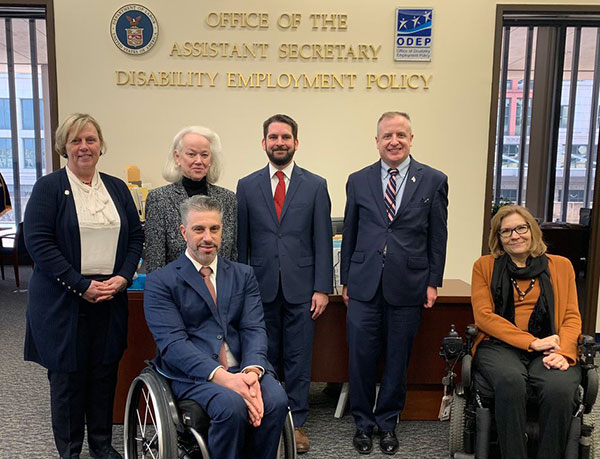
Victor Calise, front-left, is one of the authors (photo: @NYCCalise)
In the fairest big city in America, everyone deserves the opportunity to be employed. Unfortunately, the reality is that people with disabilities in the United States are twice as likely to be out of the workforce as their nondisabled peers.
Data collected by the Bureau of Labor Statistics at the U.S. Department of Labor shows that the proportion of Americans with disabilities ages 16 to 64 that was employed last year was only 30.4% compared to 74% for non-disabled individuals in the same age group. In New York City alone, 79% of working-age people with disabilities are currently jobless according to the most recent U.S. Census statistics. This staggering disparity is one of the most pressing challenges to full accessibility and independence of the disability community.
New York City is doing our part to increase the employment rate of people with disabilities. The Mayor’s Office for People with Disabilities’ (MOPD) NYC: ATWORK program is a first-of-its-kind public-private partnership, with funding from Institute for Career Development (ICD), the Poses Family Foundation, the Kessler Foundation, the Craig H. Neilsen Foundation, ACCES-VR, and The Mayor’s Fund to Advance New York City that directly connects people with disabilities to prospective employers.
For example, Chelsea Dimond is a person with a disability who reached out to NYC: ATWORK after she was previously unsuccessful in finding employment through traditional job-seeking websites. After getting guidance regarding the search and interview process, she was ultimately hired as a Peer Respite Worker by Transitional Services Inc. New York.
On NYC: ATWORK’s assistance, Chelsea says: “This program took note of exactly what kind of job I was interested in and made a perfect match for me. This job feels like it was meant to be, and now I’m able to make a difference in the lives of those who have mental illnesses like myself.” Chelsea is only one of many examples of successful placement by NYC: ATWORK. The overall goal of this three-year initiative focuses on connecting 2,100 individuals with disabilities to internships, jobs, and careers in their field of choice.
The City’s proactive approach to increasing employment for people with disabilities is rooted in the understanding that a good job and financial security are crucial to personal and professional independence. Before connecting with NYC: ATWORK, Simon Bondar was living with his parents. After working with MOPD on his resume and interview prep, he was hired by UNIQLO as a Sales Associate. With this new line of income, Simon was able to move into a new apartment with his wife.
New York’s business community plays a crucial role in hiring more people with disabilities, in turn creating a more inclusive workplace that leverages the diversity of its employees. Through NYC: ATWORK’s Business Development Council, the City has fostered relationships with companies across a variety of sectors including finance, hospitality, transportation, retail, and technology.
Additionally, the New York City Council has hired its first-ever liaison to New Yorkers with disabilities. Together, the de Blasio Administration and Council are dedicated to including disability in conversations about diversity in hiring practices and society at large.
Having an employee with a disability can be a catalyst for a cultural shift to a more inclusive workplace. Nondisabled business owners are more likely to think about accessibility and ultimately improve the company for all of its employees and customers alike. These employment opportunities also extend to city government where the 55-a program has paved the way for qualified people with disabilities to get hired without needing to take a Civil Service exam. By obtaining employment, a person with a disability will therefore not only gain the tools they need to live independently but will also make a positive impact on their employer and the community at large as well.
While New York City has made great strides to improve the lives of people with disabilities and many businesses have joined us in hiring members of the disability community, we know this is just the beginning. It is imperative that societal attitudes shift to recognize that disability is an important aspect of a diverse work environment and, indeed, that people with disabilities are productive employees who will positively contribute to a business and the community. All of us must make a conscious effort to recruit, hire, and retain qualified people with disabilities. Only then can we have a truly inclusive society and make New York the most accessible city in the world.
***
Victor Calise is the commissioner of the Mayor’s Office of People with Disabilities. City Council Member Justin Brannan represents parts of Brooklyn. On Twitter @NYCCalise & @JustinBrannan.
***
Have an op-ed idea or submission for Gotham Gazette? Email This email address is being protected from spambots. You need JavaScript enabled to view it.




